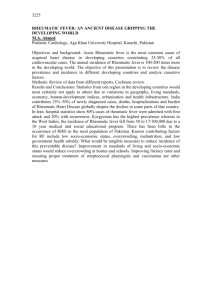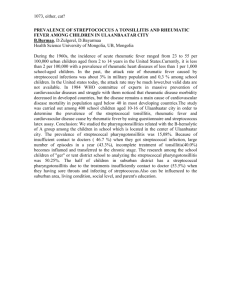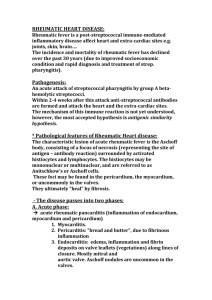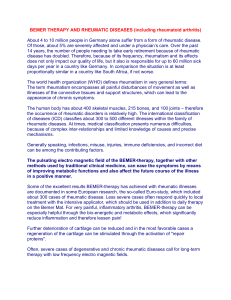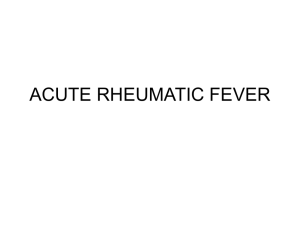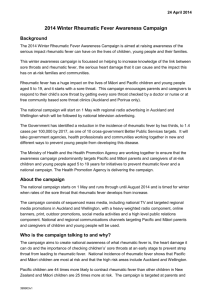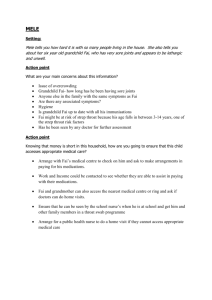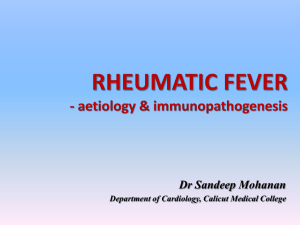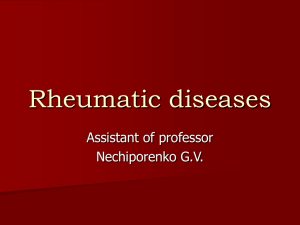Rheumatic fever
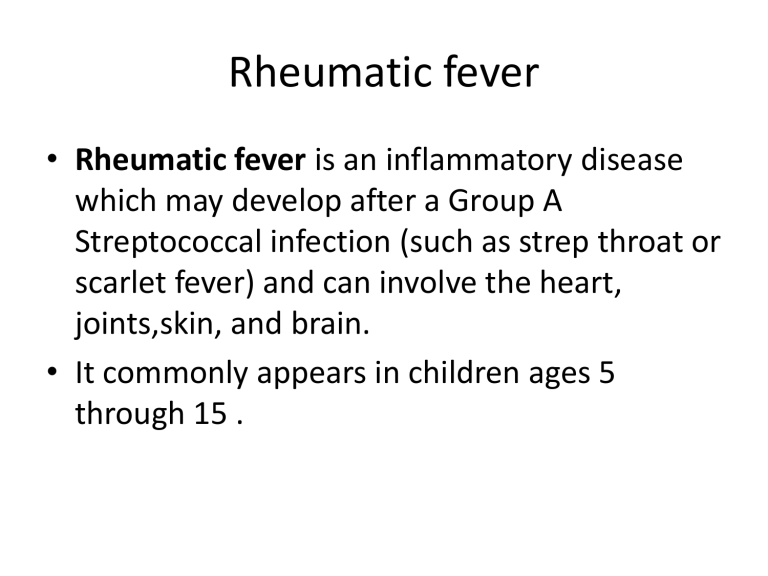
Rheumatic fever
• Rheumatic fever is an inflammatory disease which may develop after a Group A
Streptococcal infection (such as strep throat or scarlet fever) and can involve the heart, joints,skin, and brain.
• It commonly appears in children ages 5 through 15 .
Diagnosis:
• Major criteria
• Joints (Migratory polyarthritis): a temporary migrating inflammation of the large joints, usually starting in the legs and migrating upwards.
• Carditis: inflammation of the heart muscle which can manifest as CHF with shortness of breath, pericarditis with a rub, or a new heart murmur.
• Nodules (subcutaneous nodules - a form of Aschoff bodies): painless, firm collections of collagen fibers on the back of the wrist, the outside elbow, and the front of the knees. These now occur infrequently.
• Erythema marginatum : a long lasting that begins on the trunk or arms as macules and spread outward to form a snakelike ring while clearing in the middle. This rash never starts on the face and is made worse with heat.
• Sydenham's chorea (St. Vitus' dance): a characteristic series of rapid movements without purpose, of the face and arms. This can occur very late in the disease.
• Minor criteria
• Fever: temperature elevation
• Arthralgia: Joint pain without swelling
• Laboratory abnormalities: increased ESR, increased C Reactive Protein,leukocytosis.
• ECG abnormalities: a prolonged PR interval
• Evidence of Group A Strep infection: positive culture for Group A Strep, elevated or rising
Anti-sterptolysin “O” titres.
• Previous rheumatic fever or inactive heart disease
Other signs & symptoms:
• Abdominal pain.
• Nosebleeds.
Pathophysiology:
• Rheumatic fever is a systemic disease affecting the peri-
arteriolar connective tissue and can occur after an untreated
Group A streptococcal pharyngeal infection.
• It is believed to be caused by antibody cross-reactivity. This
cross-reactivity is a Type II hypersensitivity reaction and is termed molecular mimicry.
• Usually, self reactive B cells remain anergic in the periphery without T cell co-stimulation. During a Strep. infection activated antigen presenting cells such as macrophages present the bacterial antigen to helper T cells.
• Helper T cells subsequently activate B cells and induce the production of antibodies against the cell wall of
Streptococcus.
• However the antibodies may also react against the myocardium and joints, producing the symptoms of rheumatic fever.
• Group A streptococcus pyogenes has a cell wall composed of branched polymers which sometimes contain "M proteins" that are highly antigenic.
• The antibodies which the immune system generates against the "M proteins" may cross react with cardiac myofiber protein myosin and smooth muscle cells of arteries, inducing cytokine release and tissue destruction.
• This inflammation occurs through direct attachment of complement and Fc receptor-mediated recruitment of neutrophils and macrophages.
• Characteristic Aschoff bodies, composed of swollen eosinophilic collagen surrounded by lymphocytes and macrophages can be seen on light microscopy. The larger
macrophages may become Aschoff giant cells.
• Acute rheumatic valvular lesions may also involve a cellmediated immune reaction as these lesions predominantly contain T-helper cells andmacrophages.
• In acute RF, these lesions can be found in any layer of the heart and is hence called pancarditis.
• The inflammation may cause a serofibrinous pericardial exudates described as “bread-and-
butter”pericarditis, which usually resolves without sequelae.
• Involvement of the endocardium typically results in
fibrinoid necrosis and verrucae formation along the lines of closure of the left-sided heart valves. Warty projections arise from the deposition, while subendothelial lesions may induce irregular thickenings called MacCallum plaques.
Complications of Acute Rheumatic fever:
• Some patients develop significant carditis which manifests as congestive heart failure.
• This requires the usual treatment for heart failure: diuretics and digoxin.
•
• Unlike normal heart failure, rheumatic heart failure responds well to corticosteroids.
Rheumatic fever
• Annual incidence:
– Western Europe 1/100,000
– Sub-Saharan Africa 5,700/100,000
• Incidence decreases with improving social circumstances (less crowding).
• Individual (HLA) susceptibility is also important
Group A
b-
haemolytic streptococcus
• All cases associated with recent infection (e.g. pharyngitis, pyoderma).
• Some bacterial serotypes (M antigen) are more significant in causing rheumatic fever.
• Antibody and cellular immune response cross-reacts with human connective tissue.
Clinically
• Joints (arthritis)
• Heart (arrhythmias etc.)
• Skin (erythema marginatum)
• Central nervous system (chorea)
• Mainly 5-15 years (20% adult)
“Licks the joints but bites the heart”
Pancarditis…
• Pericarditis
• Myocarditis
• Endocarditis – responsible for chronic valvular damage
Rheumatic vegetations on valve
Fibrinous “Bread & Butter”pericarditis:
Acute, recurring, chronic:
• Symptoms prone to recur with subsequent
Strep. Infections
• Chronic disease leads to fibrosis (chordae of heart valves + valve cusps)
Histopathology
• Aschoff bodies (small granulomas around necrotic collagen – T cells, macrophages)
• Anitschkoff cell – an unusual spindly macrophage
Aschoff nodule and Anitschkow cell
Chronic rheumatic heart disease:
• Chronic rheumatic heart disease is characterized by repeated inflammation with fibrinous resolution.
• The cardinal anatomic changes of the valve include leaflet thickening, commissural fusion and shortening and thickening of the tendinous cords.
• Rheumatic heart disease is the most serious complication of rheumatic fever.
Rheumatic valve disease
• Most common lesion is mitral stenosis.
• Aortic valve second most frequently involved.
Normal vs. chronic rheumatic valve
Morphology in Chronic rheumatic heart disease:
• Characterized by organisation of the acute inflammation & subsequent fibrosis.
• The valvular leaflets become thickened & retracted,causing permanent deformity.
• MV,TV leaflet thickening,commisural fusion & shortening,thickening & fusion of tendinous chords.
• Micro: Diffuse fibrosis, neovascularization of the originally avascular valve leaflet.
